Since the outbreak of WWII, hydro-electric dams were considered one of the many important strategic bombing targets in Germany. By 1942, they were heavily protected by flak guns and torpedo nets and the Allies Air Forces had no effective means of destroying them. The existing bombs and bombing methods at the time would had little effect on them. Also, the British was seeking a means of destroying the German battleship Tirpitz which posed a threat to Allied shipping in the North Atlantic and had already survived a number of attempts to destroy it. The Tirpitz was safe from attack being moored in Norwegian fjords surrounded by torpedo nets. The Tirpitz moored: IWM C 4122

Sir Barnes Neville Wallis (26 September 1887 – 30 October 1979) was an English aeronautical engineer, scientist and inventor. His achievements was the geodetic (also known as geodesic) design used in the gasbag wiring of the R100 airship in 1930 and later used on the Vickers Wellington bomber and other aircraft. He was a pioneer of colour coded electrical wiring and later designed the “Tallboy” (6 tonnes) and the “Grand Slam” (10 tonnes) deep-penetration earthquake bombs.

In early 1942, Wallis began experimenting with skipping marbles over water tanks in his garden and in April 1942 wrote a paper titled “Spherical Bomb — Surface Torpedo”. The principle was similar to skipping a stone across the surface of a pond. The bouncing bomb was a special bomb designed to bounce towards a target across the water surface in a calculated manner to overcome obstacles such as torpedo nets then hit the target and detonate similar to a naval depth charge. After some initial skepticism and a demonstration, the RAF accepted Wallis’s bouncing bomb to be used in attacks on dams in the Ruhr area of Germany. In November 1942, it was decided to develop a large version of the bomb for use against dams and a smaller version for use against ships. They were code named “Upkeep” and “Highball” respectively.
UPKEEP
Testing of the Upkeep prototypes with inert filling was carried out at Chesil Beach, Dorset, flying from RAF Warmwell in December 1942, and in April 1943 at Reculver, Kent, flying from RAF Manston using a Vickers Wellington bomber. Originally envisaged as a spherical bomb, early prototypes actually consisted of a cylindrical bomb within a spherical casing. During testing, it was found that the spherical casing shattered on impact with the water and that the inner cylinder containing the bomb continued across the surface of the water as intended. As a result, the spherical casing was eliminated from the design. Development and testing was completed on 13 May 1943 with the dropping of a live cylindrical Upkeep bomb 5 miles (8 km) out to sea from Broadstairs, Kent.

Film: Bouncing Bomb
The bomb had to be dropped at precisely 60 feet (18 m) above the water at 232 miles per hour (373 kph) ground speed, with a back-spin at 500 rpm enabled the bomb to bounce 7 times over some 800 yards (731.52 meters). Back-spin is a normal feature in the flight of golf balls, caused by how they were struck by the club, and for that reason all forms of the bomb which were developed were named “Golf mines” and some of the spherical prototypes had dimples.
On 21 March 1943, the RAF 617 Squadron was formed under great secrecy at RAF Scampton which also included RCAF, RAAF and RNZAF personnel. The squadron had to develop the tactics to deploy the Upkeep bomb and undertook some of its training over the dams of the Upper Derwent Valley in Derbyshire, as the towers on those dam walls were similar to those to be found on some of the dams in Germany.
The bomber selected to deliver the Upkeep bomb was the Avro Lancaster B.III. The modified bomber was called the “Type 464 (Provisioning) Lancaster” or the Lancaster B.III (Special). A total of 23 Lancasters were converted to carry a single Upkeep bomb at Woodford Aerodrome near Stockport. The bomb bay doors were removed and Vickers-built struts to carry the bomb were fitted in their place. The mid-upper turret was removed to save weight and the gunner was moved to the front turret. A hydraulic motor, driven by the pump previously used for the mid-upper turret was fitted to spin the bomb.
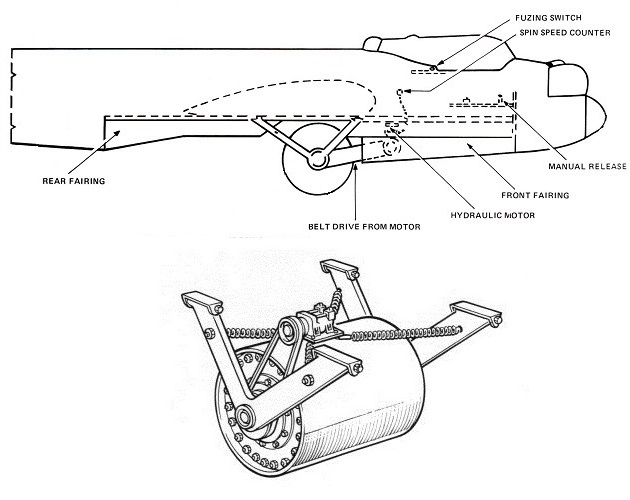
The operational version of Upkeep, known by its manufacturer as “Vickers Type 464” used the explosive charge Torpex originally designed for use as a torpedo explosive which provided a longer explosive pulse for greater effect against underwater targets. The principal means of detonation was by three hydro-static pistols, as used in depth charges, set to fire at a depth of 30 feet (9 m). The overall weight was 9,250 lbs (4,200 kg) of which 6,600 lbs (3,000 kg) was Torpex. Provision was also made for self destruct detonation by a fuse which was armed automatically when the bomb was dropped from the aircraft and timed to detonate after 90 seconds.

A practice Upkeep bomb attached to the bomb bay of Wing Commander Guy Gibson’s Lancaster, AJ-G ED932, at Manston, Kent, while conducting dropping trials off Reculver, early May 1943. Gibson was the CO of 617 Squadron.
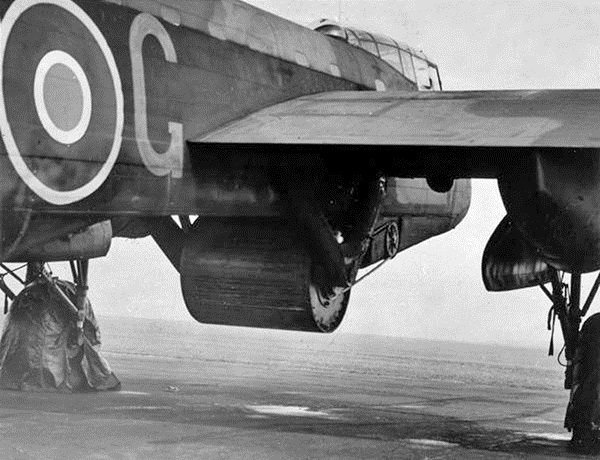
The practice Upkeep bomb seen from the front.

OPERATION CHASTISE
On the night of 16–17 May 1943, 617 Squadron attacked the German dams in the Ruhr valley in Germany. The date of the raid was selected based on the target dams being as full as possible from seasonal rainfall to achieve maximum effectiveness.
The dams that were primary targets were the Möhne, Eder, Sorpe and the secondary targets were the smaller Ennepe, Lister, and Diemel dams. The Möhne dam was protected by two torpedo nets in the water and 20mm/37mm flak guns positioned along the banks and on each of the two towers. The Germans believed the Eder dam was impossible to attack due to the surrounding large hills. There were no torpedo nets or AA guns, only two patrolling guards on the dam armed with rifles. The Sorpe dam was different being a huge earthen dam. Before the attack on the Sorpe, the bomb was not spun backwards and the approach was made along the length of the dam instead of perpendicular to the dam over the reservoir.
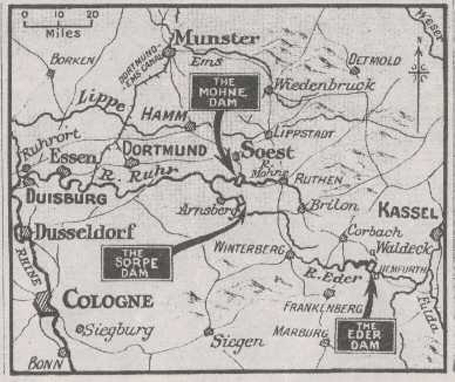
The squadron was divided into three waves for the raid.
Wave No. 1 was composed of 9 bombers in 3 groups and assigned to attack the Möhne Dam. Any bombers with bombs remaining would then attack the Eder Dam.
Wave No. 2 consisted of 5 bombers was assigned to attack the Sorpe Dam.
Wave No. 3 was the mobile reserve consisting of 5 bombers. It took off two hours later on May 17 and was either to attack the main dams or to attack the three smaller secondary target dams: Lister, Ennepe or Diemel.
Two crews were unable to make the mission due to illness.
617 Squadron: Crew Names
The Bombers took two separate routes which carefully avoided known flak concentrations and they were timed to cross the enemy coast simultaneously. They flew low at about 100 ft (30 m) altitude for the whole flight to the targets to avoid radar detection.
THE ATTACK
Ten minutes before the attack, the cylindrical Upkeep bomb was spun backwards at 500 rpm and the bomb was released by allowing the calipers to spring outwards.
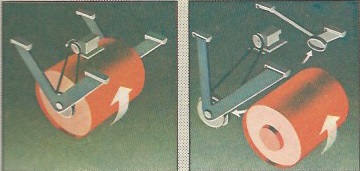
During the attack run, getting the bomber in the proper position for a successful bomb release was a team effort by the crew. The flight engineer had to control the bomber’s speed to the required speed for the bomb release. The pilot concentrated on the plane’s height and keeping the bomber level. The pilot determined the bomber’s height by viewing a pair of intersecting spotlight beams which when they converged on the surface of the water indicated that the bomber was at the correct height for bomb release.
The forward light was mounted beneath the bomber’s nose pointing straight down and the rear angled light was mounted at the rear of the open bomb bay. If the bomber was too high, the rear angled beam would strike the water ahead of the forward beam. If the bomber was too low, the rear angled beam would strike the water behind the forward beam. The arrangement was effective but risky. All through the attack run, the two lights pinpointed the bomber’s location for the enemy gunners. If either of the two lights were knocked out by flak or malfunctioned, the crew could not determine the correct height for the bomb release.
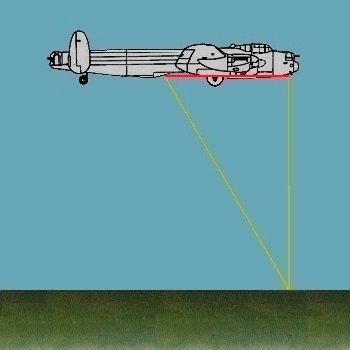
The angle of the rear light can be calculated by using this trigonometry equation: Angle Beta = ARCTAN(Leg B / Leg A). Leg B is the distance from the forward light to the rear light (the red line) and Leg A is the distance from the forward light straight down to the surface of the water. The angled beam of light is the hypotenuse of a right triangle. Today, there are free trigonometry calculators available on the internet. Back in the early 1940’s, engineers used tables and a slide ruler to make these calculations.
The bomb aimer tracked the distance to the target by using a simple, hand-held, triangular device. With one corner held up to his eye, projections on the other two corners would line up with predetermined points on the dam when they were at the correct distance for the bomb release.

Similarly, the angle which the arms on the device had to be set to could be calculated by using the equation: Angle Alpha = ARCTAN(Leg A / Leg B). Leg A is one half the distance between the two towers on the dam and Leg B is the distance from the bomber to the dam (center red line). The angled lines of sight (in yellow) are the hypotenuse of right triangles. Note the torpedo nets protecting the Möhne dam.
When the bomber was at the correct distance from the dam wall, the speed and height were perfect, the bomb aimer then released the bomb. Many of the bombers made multiple run attempts before releasing, each time being exposed to flak. Even after releasing their bomb, some bombers made additional runs at the dam providing cover fire for the other bombers.
After release, the bomb skipped along the surface of the reservoir water hurdling over the protective torpedo nets and the bomb would strike against the inner face of dam where it sink down along the dam wall where it exploded. The ‘earthquake’ effect of the bomb blast weaken the dam structure and while under the pressure of the water the dam wall would crack and then eventually collapse.

While the bomb was bouncing towards to dam, the bomber and crew had to gain height slowly as any sudden turn at that low altitude had the risk of dipping a wing into the water or crashing into the surrounding hills. So the bomber continued along the same course as the bouncing bomb while still exposed to flak.
The bomber which breached the Möhne dam.

| Bomber | Wave | Battle Notes | Crew |
| AJ-G ED932 | 1 | Bomb dropped short of the Möhne dam. | 7 Returned |
| AJ-M ED925 | 1 | Attacked Möhne, hit by flak and crashed. | 5 KIA, 2 PW |
| AJ-P ED909 | 1 | Bomb missed the Möhne dam. | 7 Returned |
| AJ-A ED887 | 1 | Damaged Möhne, shot down after attack. | 7 KIA |
| AJ-J ED906 | 1 | Hit Möhne dam and a massive breach. | 7 Returned |
| AJ-L ED929 | 1 | Hit Eder dam but no breach. | 7 Returned |
| AJ-Z ED937 | 1 | Bomb bounced over Eder and shot down. | 7 KIA |
| AJ-B ED864 | 1 | Hit high-tension wires at Haldern, crashed. | 7 KIA |
| AJ-N ED912 | 1 | Hit Eder dam and a massive breach. | 7 Returned |
| AJ-T ED825 | 2 | Hit Sorpe dam but no breach. | 7 Returned |
| AJ-K ED934 | 2 | Hit by flak and crashed into the sea. | 7 KIA |
| AJ-E ED927 | 2 | Hit electricity pylon and exploded*. | 7 KIA |
| AJ-H ED936 | 2 | Clipped sea on way to dams, lost bomb. | 7 Returned |
| AJ-W ED921 | 2 | Hit by flak, electical failure and aborted. | 7 Returned |
| AJ-Y ED924 | 3 | Did not attack due to fog and aborted. | 7 Returned |
| AJ-O ED886 | 3 | Attacked Ennepe** dam but no breach. | 7 Returned |
| AJ-F ED918 | 3 | Hit Sorpe dam but no breach. | 7 Returned |
| AJ-C ED910 | 3 | Hit by gunfire and crashed. | 6 KIA, 1 PW |
| AJ-S ED865 | 3 | Hit trees and crashed. | 7 KIA |
* AJ-E crashed just outside the village of Haldern near the German-Dutch border.
** AJ-O might have attacked the Bever dam by mistake due to fog.
The Sorpe dam only sustained minor damage and the Diemal and Lister dams were not attacked.
Out of the 19 bombers that went on the raid, 8 did not return. Out of the 133 airmen, 53 were KIA (about 40%) and 3 became POWs. It was an unacceptable loss rate at the time but it appalled Barnes Wallis.
Just two bombs breaching the Möhne and Eder dams unleashed million tons of water from the reservoirs which swept down through the valleys led by a tidal wave sometimes 40 feet (12.2 m) high traveling at a speed of 6 yards per second (5.5 Meter/second) created floods that expanded about a hundred miles (161 km).
The damages:
– In Günne, three hydro-electric plants were destroyed and several more damaged.
– 92 factories damaged and 12 were destroyed.
– 8 bridges damaged and 25 destroyed.
– Hundreds of square miles of arable farmland were wiped out and left infertile.
– Deposits of pollutant fuels, heavy metals and sewage sludge smeared across land.
The breached Möhne dam after the raid.
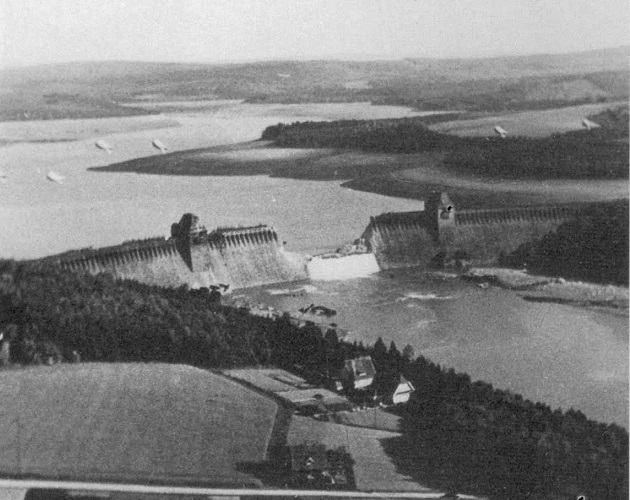
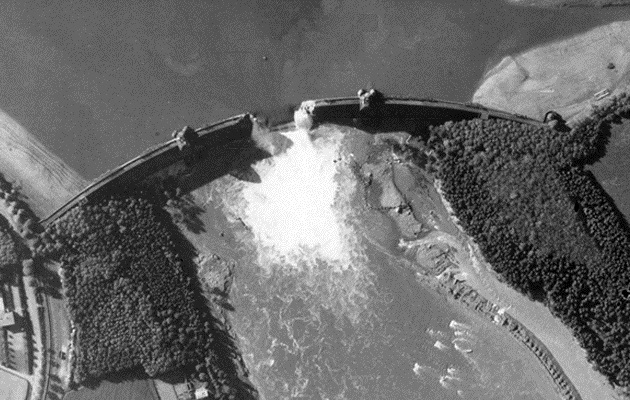
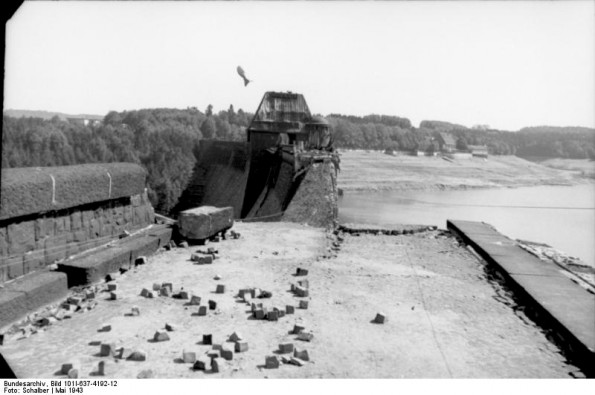
The breached Eder dam after the raid.

When the raid began, air-raid sirens wailed across the region causing many civilians fearing bombs, blast and flames, to seek shelter in their cellars. The dam might be breached was beyond comprehension for the Germans.
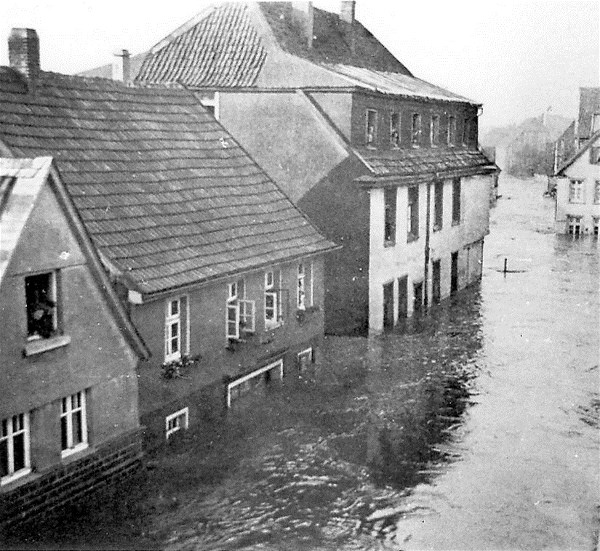
In the village of Himmelpforten, its 13th-century church vanished beneath a wall of water with its bells still ringing. The bell tower remained visible for a few moments then collapsed beneath the water and then went silent. A timbered building was seen floating by, in which a candle still flickered behind a window.

An article written by German historian Ralf Blank stated, at least 1,650 people were killed: around 70 of these were in the Eder Valley, and at least 1,579 bodies were found along the Möhne and Ruhr rivers with hundreds missing. 1,026 of the bodies found down river of the Möhne dam were foreign POWs and forced laborers in numerous camps mainly from the USSR. The city of Neheim (now part of Neheim-Hüsten) was hit the hardest located at the confluence of the Möhne and Ruhr rivers where over 800 people perished and among them were at least 493 Russian female forced laborers. Besides the human losses, thousands of farm livestock perished in the flood waters.
For his part in the raid, Guy Gibson was awarded the Victoria Cross. He was withdrawn from flying due to the high number of missions he had been on and went on a publicity tour. Sadly, Gibson did not survive the war. On 19 September 1944, Gibson and his navigator were returning from a night mission over Germany when their Mosquito was shot down in a friendly fire incident by the rear gunner in a Lancaster from 61 Squadron who mistook them for a Junkers Ju88. The Mosquito and the Ju88 did bear a striking resemblance to each other especially at night. Gibson and his navigator were both killed.
It was after the raid when the 617 Squadron received the nickname “The Dambusters”. Operation Chastise was the only time the Upkeep bomb was used in combat. Throughout the rest of the war, the squadron continued in a specialist and precision-bombing role including dropping “Tallboy” and “Grand Slam” deep penetration earthquake bombs on targets such as concrete V-2 launching sites, U-boat pens and bridges.
Film: Dam Busters
Film: 17th May 1943: RAF No. 617 Squadron carries out the ‘Dambusters’ raid
Film: Barnes Wallis – Dambusters Revealed
HIGHBALL
From November 1942, development and testing of the Highball bomb progressed alongside that of Upkeep, including the dropping of prototypes at both Chesil Beach and Reculver. At Chesil Beach, they were dropped by the modified Wellingtonbomber and at Reculver by a modified de Havilland Mosquito B Mk IV, one of two assigned to Vickers Armstrong.

During tests at Reculver in mid April 1943, it was found that Highball’s spherical casing suffered similar damage to that of Upkeep. The design was altered by strengthening the casing with steel plate. Further testing was carried out by three modified Mosquitoes flying from RAF Turnberry, north of Girvan, on the west coast of Scotland, against a target ship, the former French battleship Courbet, which had been moored for the purpose in Loch Striven. During testing, there were problems with aiming and releasing the Highball bomb.
These is my close up of IWM MH 4583

View of the Highball bomb bay on a Mosquito bomber.

Highball was a sphere with flattened poles and the explosive charge was Torpex enclosed in a cylinder. Detonation was by a single hydro-static pistol, set to fire at a depth of 27 feet (8 m). Its weight was 1,280 pounds (581 kg), of which 600 pounds (272 kg) was Torpex.
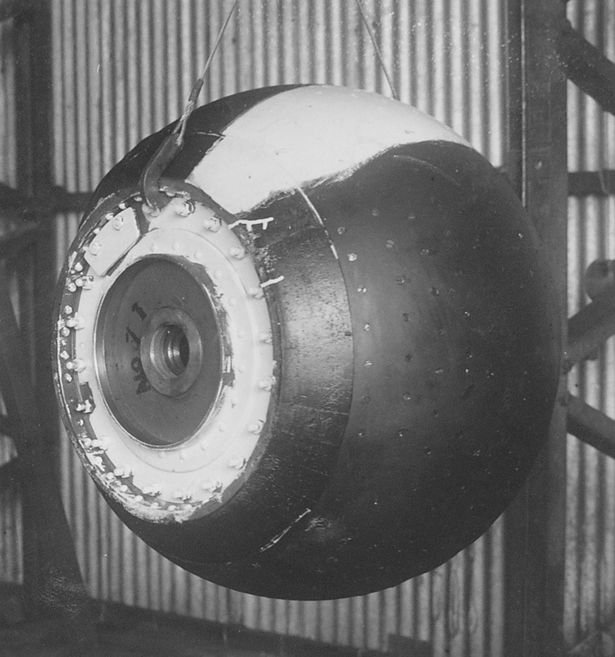
This was a test launch where two Highballs were released one second apart.

Film: WWII Bouncing Bomb Tests at Ashley Walk, New Forest 1943
While there were continuing problems in the testing of Highball, it was decided that Upkeep was to be deployed independently of Highball. At the end of March 1943, it was determined that the aircrews would need at least two months of special training. 618 Squadron had been formed on 1 April 1943 at RAF Skitten, near Wick, in northeastern Scotland, to undertake Operation Servant in which the German battleship Tirpitz would be attacked with Highball bouncing bombs.
On April 18, it was ordered that Operation Servant to be undertaken before the end of June since 618 Squadron could not be held for the operation indefinitely. In early September 1943, due to the continuing problems with Highball most of 618 Squadron were released for other duties. That meant Operation Servant was abandoned and core personnel of 618 Squadron were retained to continued work on the development of Highball.
By the end of May 1944, problems with with aiming and releasing the Highball had been resolved. Aiming Highball required a different method from Upkeep. The problem was solved with Wallis’s design of a ring aperture sight fixed to a flying helmet.
The Highball was never used operationally. On 12 November 1944, in Operation Catechism, 29 Lancasters with Tallboy bombs sank its primary target, the Tirpitz. Other potential targets had been considered during Highball’s development and later. These included the ships of the Italian navy, canals, dry docks, submarine pens, and railway tunnels (for which testing took place in 1943). But Italy surrendered in September 1943, and the other target ideas were dismissed as being impracticable.
In January 1945, at the Vickers experimental facility at Foxwarren, near Cobham, Surrey, an USAAF Douglas A-26 Invader was converted to carry two Highballs almost completely enclosed in the bomb bay, using parts from a Mosquito conversion. After brief flight testing in the UK, the kit was sent to Wright Field, Ohio, USA. Twenty-five inert Highballs, renamed “Speedee” bombs, were also sent for use in the USAAF trials.
On 28 April 1945, Douglas A-26C-25-DT Invader, 43-22644, assigned to the 611 Base Unit at Wright Field, crashed into the Choctawhatchee Bay, 3 miles (4.8 km) northeast of Fort Walton, Florida, after being hit by a test Speedee (Highball) bouncing bomb which tore off the tail section and the bomber immediately nosed over into the water. It had taken off from Eglin Field, Florida, on a low level bombing exercise at AAF water range Number 60, south of Lake Lorraine. All 3 crewmen did not survived.
Film: Douglas A-26C breaks apart in mid-air testing a bouncing bomb
BASEBALL
Baseball was a smaller bomb for use by motor torpedo boats (MTB) proposed by the Admiralty in December 1942. It would been a tube-launched weapon weighing 300 pounds (140 kg) where half of it would be filled with explosives and had an expected range of 1,000 to 1,200 yards (910 to 1,100 m). It never left the drawing board.
GERMAN BOUNCING BOMB
After the raid on the dams, the Germans discovered an Upkeep bomb intact in the wreckage of the Lancaster AJ-B ED864 which hit high-tension wires and crashed on land. The bomb had not been released and the detonation devices did not fired.
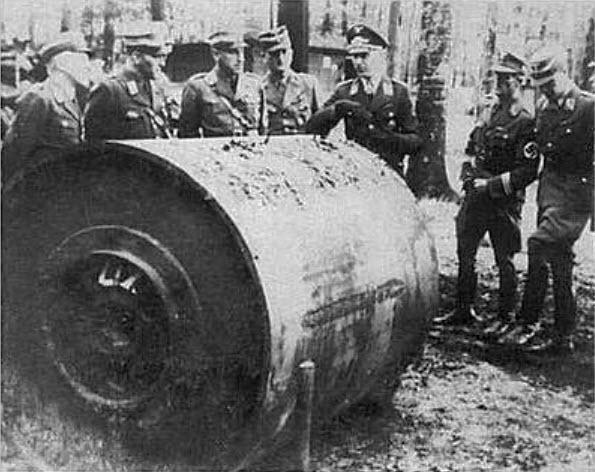
The Germans built their own 385 kg (849 lb) version code named “Kurt” which was similar to the Highball. Not understanding the importance of the backspin, Kurt was rocket-assisted. The rocket broke off on contact with the water then the bomb bounced over the water up to 500 yards (457.2 m) before sinking along side the target and exploded at a given depth by a hydro-static fuse. Kurt was extensively tested, initially using a twin engine Me 410 and later experimental drops were made by a single engine Focke-Wulf Fw 190 which was capable of carrying two bouncing bombs. Kurt was never used operationally and the project was cancelled in 1944.
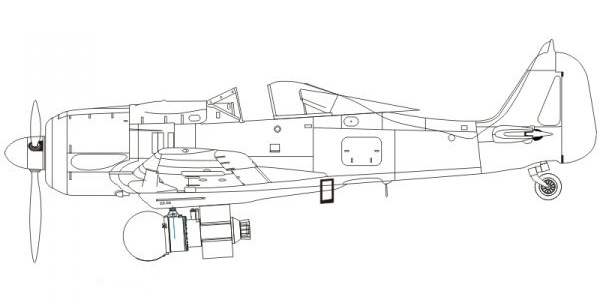
This is a post war drawing of Kurt.

Film: Kurt- German bouncing bomb
Film: GERMAN ADVANCED & SECRET WEAPONS FOOTAGE 3475
BOOK AND MOVIES
The 1955 film was based on Paul Brickhill’s 1951 book “The Dam Busters”.

A excellent film but the scenes of the bombs skipping on the surface of the water towards the dams was actually footage of the early prototype bomb tests. The bombs back spinning was concealed because it still secret at the time of filming where the bombs in the footage were painted over frame by frame. The shape of the bombs were incorrect being spherical instead of the Upkeep cylindrical shaped bombs used in the actual raid.
Mosquito Squadron (MGM-UA, 1969)
This post Great Escape/633 Squadron war-adventure film contains actual test footage of the Highball bombs shot at Ashley Walk bombing range at New Forest. The special Highball bomb sight seen in the film is also a genuine representation of the sight used for dropping the Highball bomb. The film’s plot is otherwise mostly fictional.

George Lucas was influenced by the 1955 Dam Busters Film when he created Star Wars: Episode IV – A New Hope (1977).
Video: Star Wars homage or rip-off of The Dam Busters
Video: Dam Busters a La Star Wars
MODEL KITS
Amodel 1433 1/144 Avro Lancaster B.III Dambuster – 2009
(Decals only for AJ-N)
Airfix 08004 1/72 Avro Lancaster B.III DAM BUSTER – 1993/1994
(Decals for AJ-G and AJ-S)
Revell 04630 1/72 Avro Lancaster “Dam Buster” – 2001
(Decals for AJ-G, AJ-J and AJ-P)
Tamiya 61021 (Also listed as MA-121) 1/48 Dambuster Grand Slam Bomber Lancaster BIII Lancaster BI Special 22000LB Bomb – 1975
Tamiya 61111 1/48 Dambuster/Grand Slam Bomber Avro Lancaster B Mk.III Special “DAMBUSTER”/B Mk.I Special “GRAND SLAM BOMBER” – 2012
(Decals for AJ-G and AJ-Q)
HK Models 01E011 1/32 Avro Lancaster B.Mk.III Dambuster – 2019
(Decals only for AJ-G)
Kora Models KPK72115 1/72 Focke-Wulf Fw 190F-8 with bouncing bomb SB800RS Kurt Version 2 & Version 3 – 2019
Paragon Designs 1/72 Mosquito Twin Highball Conversion (Resin kit)

Mike, I found your website a few months ago and have read all of your posts. I absolutely love them… the topics, details, links and extras at the end are great. Please keep up the good work and I’m looking forward to your next one. Cheers.
LikeLike
Plaque honoring Guy Gibson and James Warwick
LikeLike
Like the site. Lots of interesting information.
I did notice the bomb shape was incorrect on the lancasters in the movie.
I am building a 1:72 revel model at the moment.
LikeLike